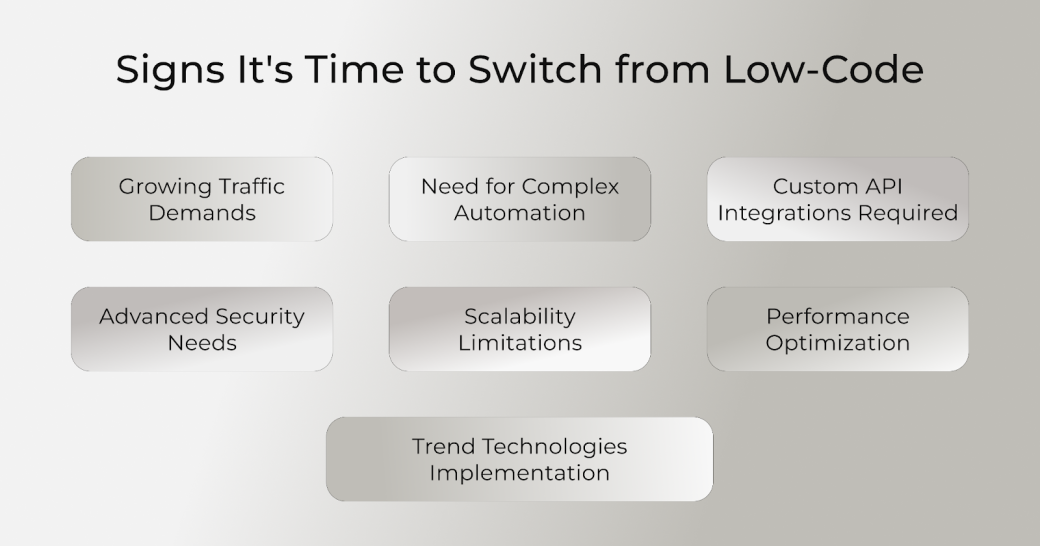

Updated July 22, 2025
While low-code development has been around since the 80s, by the mid-2010s, it has seen a huge growth in popularity. Its simplicity, compared to other development approaches, makes it a favored choice for many developers looking for efficient and streamlined ways to create bespoke software solutions and applications. This article discusses the pros and cons of low-code development to help you decide if it's time to shift.
The Precedence Research platform claims that the global low-code development platform market size was estimated at $10.46 billion in 2024, and it’s expected to continue growing at a 22.92% CAGR up to 2034. This positive trend can be explained by the fact that nowadays, to remain competitive, businesses have to offer their target audiences new services and interaction ways as often as possible and faster than competitors (of course, in the currently relevant digital format), and what, if not low-code platforms, can provide them with an accelerated software development cycle.

Looking for a Software Development agency?
Compare our list of top Software Development companies near you
Indeed, initially, low-code platforms were created as solutions for rapid digital transformation, allowing businesses to launch new web and mobile applications with minimal involvement of developers' hard skills and, instead, practicing a drag-and-drop approach using graphical interfaces and configured modules.
However, the low-code programming is not one-size-fits-all. Below, we will analyze your limitations when resorting to it. We will also consider alternative options to help you scale previously created solutions, sharpening them for newly emerging needs and goals.
Let's consider a specific example from our experience: one of our clients set a rather ambitious task: to create a platform for virtual events capable of scaling from small meetings to conferences with hundreds of thousands of participants. The main product requirements included:
We settled on the low-code approach and, respectively, Webflow, which allowed us to quickly adapt the design to the client's requirements, speed up the development process, and simplify platform customization without diving deep into the code. We also used React and implemented integrations with HubSpot, MailChimp, and Zoom.
Such a tech stack and, of course, our team's experience allowed us to achieve impressive results:
Using low-code platforms also carries some risks. For example, regardless of the platform, customization options will be limited, and the implementation of complex business logic or, for example, integration with non-standard APIs will still require workarounds. You also become dependent on the platform, and if, at some point, it stops supporting certain functions, you may need to migrate. Finally, projects on such platforms may face performance issues under extremely high loads.

The best way out of these situations is a timely transition to a hybrid approach (for example, from Webflow to WordPress with the development of custom plugins). The prerequisites for this usually look like this:
In some cases, you may need even a more global transformation that implies the creation of a new custom solution from scratch – this is a standard option for the following cases:
In general, making a strategic decision to move from low-code to more complex development always involves an end-to-end analysis of the system's current state. That is, if the load on it grows (and standard tools can no longer cope with the increase in traffic and data volume), your business begins to need to implement tools and technologies that are not available in ready-made platforms, and/or it is necessary to ensure compliance with requirements that the selected platform cannot provide, you should consider the possibility of transition.
Also, a bright "red flag" emphasizing the fact that ready-made platforms no longer meet your needs can be a decrease in your team's efficiency; that is when their efforts to implement new features and maintain the system's operability in new operating conditions begin to slow down your business development.
The transition should be gradual and based on a clearly defined strategy. Here are the main stages it consists of:
This is a fairly basic description of the strategy in general. It can be supplemented with intermediate steps to protect your business from the most common risks. In particular, this could include pilot launches with testing of individual system components, implementation of backup with preservation of critical data before migration, and development of a rollback strategy in case of failures.
To achieve the best balance with a hybrid approach, you should consider the possible risks associated with it. The most obvious of these is technical debt since, with regular customizations, the low-code platform you choose may fail. It is also worth noting that standard CMSes contain unnecessary code, which can negatively affect performance and expose the project to cyberattacks.
In this regard, you must clearly define which tasks you will assign to the low-code platform and which will require custom development. For example:
Based on our experience, we can highlight the following performance indicators for using a hybrid approach:

Ultimately, the list of metrics will depend on each separate project and its requirements.
Low-code is an excellent option for a quick launch, but its capabilities may not be enough as your business grows. In such cases, a hybrid approach allows you to maintain the development speed without sacrificing customization. The right transition strategy and a reliable technology partner are key to its success.
Since it is quite difficult to determine the optimal development approach on your own (moreover, if you have chosen a hybrid one, distributing the functionality between low-code platforms and custom development tools can become a serious obstacle), it makes sense to turn to a development company that can provide you with a relevant expertise showcase and is naturally equally proficient in using low-code tools and turn-key solutions.
In addition, you will need to make sure that your potential digital partner provides transparent reporting, offers a clear pricing model, and offers tech support and post-release service.


